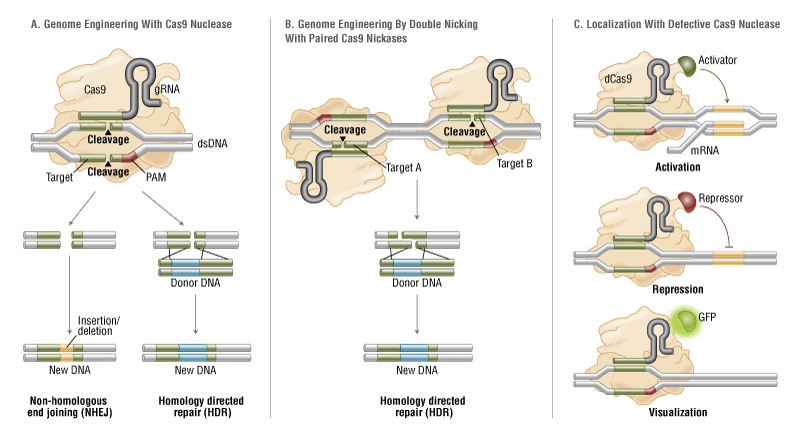CRISPR Cas-9
About CRISPR Cas-9

- CRISPR-Cas9 was adapted from a naturally occurring genome editing system in bacteria.
- The bacteria capture snippets of DNA from invading viruses and use them to create DNA segments known as CRISPR arrays.
- DNA, or deoxyribonucleic acid, is the central information storage system of most animals and plants, and even some viruses.
- The CRISPR arrays allow the bacteria to “remember” the viruses (or closely related ones). If the viruses attack again, the bacteria produce RNA segments from the CRISPR arrays to target the viruses’ DNA. The bacteria then use Cas9 or a similar enzyme to cut the DNA apart, which disables the virus.
- Ribonucleic acid (RNA) is an important biological macromolecule that is present in all biological cells. It is principally involved in the synthesis of proteins, carrying the messenger instructions from DNA, which itself contains the genetic instructions required for the development and maintenance of life. Unlike DNA, RNA is single-stranded.
- This also contains Cas (CRISPR-associated) genes that are used to produce enzymes such as Cas-9. These enzymes — the Cas-9 being a particularly popular one — can be used to chop the DNA of the virus and destroy them.
- The CRISPR-Cas9 system works similarly in the lab. As in bacteria, the modified RNA is used to recognize the DNA sequence, and the Cas9 enzyme cuts the DNA at the targeted location.
- Once the DNA is cut, researchers use the cell’s own DNA repair machinery to add or delete pieces of genetic material, or to make changes to the DNA by replacing an existing segment with a customized DNA sequence.
- Nobel Prize in Chemistry for 2020 was given to two women scientists namely Emmanuelle Charpentier (France) & Jennifer A. Doudna (Germany) for pioneering the use of CRISPR (Clustered Regularly Interspaced Short Palindromic Repeats) – Cas9 (CRISPR-associated protein 9) system as a gene-editing tool.
How can this be used to edit genomes?
- Using the tool, researchers can change the DNA of animals, plants and microorganisms with precision.
- TracrRNA which is a part of bacteria’s ancient immune system- CRISPR/Cas disarms viruses by cleaving their DNA.
- In their natural form, the scissors recognise DNA from viruses, they could be controlled so that they can cut any DNA molecule at a predetermined site and where the DNA is cut it is then easy to rewrite the code of life.
Applications
- Deliver genetic models for fundamental disease research, drug screening, and therapy development, rapid diagnostics, in-vivo editing and correction of heritable conditions like hereditary blindness, Beta thalassemia, Sickle cell disease etc.
- Medical Treatment: to create potential genome editing treatments for diseases such as HIV, cancer.
- Therapeutic Cloning: embryonic cells are cloned to obtain biological organs for transplantation.
- Research is already underway for using proteins that are smaller and more efficient than Cas-9, though the system purportedly holds promise for treating more complex diseases, such as cancer, heart diseases, mental illnesses, and the human immunodeficiency virus (HIV) infection.
- Agriculture: increase plant yield, quality, disease resistance, herbicide resistance and domestication of wild species, improved agronomic performance and breeding technologies.
Associates issues
-
- Agriculture Genetic Modification: creation of food that can cause an allergic reaction.
- CRISPR-Cas9-edited cells have been linked to cancer, according to studies from Sweden’s Karolinska Institute and Novartis, a biopharmaceutical corporation.
- In terms of ethics- Germline Editing: Germline Editing is the deliberate alteration of genes passed down to offspring and future generations, resulting in genetically changed individuals. The majority of ethical debates surrounding genome editing revolve around human germline editing as alterations in the germline are passed down to future generations.
- The germline refers to the specialized cell lineage containing and transmitting genetic information from generation to generation.
- Genetic Inequality: Through Gene-editing, wealthy people can reprogram their offspring’s with upgrades and create genetic discrimination.
- Illegal Experimentation
Associated laws in India
- “Rules for the Manufacture, Use, Import, Export and Storage of Hazardous Microorganisms/Genetically Engineered Organisms or Cells, 1989” notified under the Environment Protection Act, 1986 regulate genetically modified organisms.
- National Ethical Guidelines for Biomedical and Health Research involving human participants, 2017, by the Indian Council of Medical Research (ICMR), and the Biomedical and Health Research Regulation Bill implies regulation of the gene-editing process.
Why in News?
- A gene-editing tool that has led to new cancer therapies and a rapid test for COVID-19 is now helping scientists find endangered species of salmon.
- Sherlock, which stands for Specific High-sensitivity Enzymatic Reporter Unlocking, identifies the fish using their genomic sequence. Researchers begin by taking swabs of mucus from the fish and combining with reagents that will glow if certain snippets of DNA are present.
- By identifying the species, researchers believe they can better monitor population sizes and habitats.
Reference:
Subscribe
Login
0 Comments
